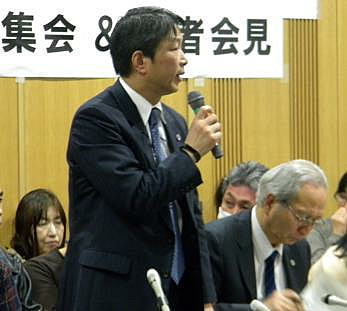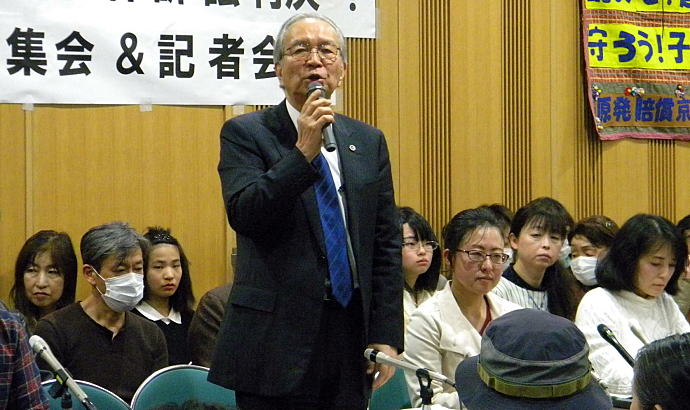|
||||
The Final brief (for the conclusion of the trial)(Read in pdf) Japanise
Lawyers for the plaintiffs Mr Hiroshi Kawanaka Mr Yasuo Tanabe 22 September 2017 To Ho A council, 7 Civil Division of the Kyoto District Court Chapter 1: Introduction 1 The plaintiffs first filed a suit to begin this court case on the 17th of September 2013. The ten days ago, on the 7th September, the Japanese prime minister gave a presentation as host of the 2020 Olympics at the IOC (International Olympic Commission) session. He said 'Some may have concerns about Fukushima. Let me assure you, the situation is under control. It has never done and will never do any damage to Tokyo.' And he said at the press conference 'As regards the contaminated water issue, I would like to mention that health problems don't exist at all in the past and for the future.' People who are concerned with the Fukushima issue could not believe his false words and dismissal of the facts. His speech was obviously criticised domestically and overseas. Four years have passed since then. If the situation of the Fukushima Daiichi Nuclear station in September 2017 was shown objectively, it would be enough to prove his representation false. Although 6000 people are working very hard every day towards the decommissioning of the nuclear reactors at Fukushima Daiichi, the condition of the nuclear fuel debris inside of reactors 1, 2 and 3 hasn't been established yet. According to the government's 'Roadmap of Nuclear Decommissioning,' the methods for eliminating and disposing of this debris and must be decided by 2017. However, it is not sure when they can decide even the date for announcing this. The situation is still in darkness. The discharge of contaminated water into the ocean cannot be prevented. Also, the frozen soil impervious wall hasn't been effective. 130 tons of contaminated water have been discharged daily. According to the Fukushima prefectural website, 'Fukushima's inshore is voluntarily halted since the disaster. Fukushima prefecture is researching in detail the effects of radioactivity on fish and shellfish. Experimental operations have started about seafood confirmed safe by our scientific data.' Why are the voluntary restraint, experimental operation and restriction of distribution still continuing? It is obvious that there are concerns about people's health. It can be said that the Fukushima nuclear power plants are not under controlled at all, even though six years have passed since the disaster. The inshore fishery in Fukushima has been controlled and marketing is limited, because of concerns that the discharge of contaminated water can cause health problems. As time passes it is becoming clear that the Prime Minister's speech was not accurate. However, the videos of his presentation and press conference are still available for the world to watch on the website of the Prime Minister of Japan and His Cabinet. He doesn't admit that his speech was incorrect. He also doesn't even apologise that the speech was a misunderstanding or created a false impression by failing to explain properly. Of course, his false presentation wasn't a misunderstanding or over-eagerness. This is the Government's basic judgement. We have to conclude that in Japanese politics lies are propagated. It is a great shame and very sad. Since the nuclear disaster of March 2011, many victims faced the lies by the Government and local authorities one after another. The most extreme was the Chief Cabinet Secretary repeated on TV 'The radiation level from the nuclear explosion will have no immediate affect on your health.' Many plaintiffs trusted and felt relieved by his announcement, and let their children play outside after the disaster. It made them suffer deep distress and regret. The safety dose limit for radiation is 1mSv per year according to the law, which says it would be too dangerous for humans if this was exceeded. But the Government raised the dose limit to 20mSv per year. If the 1mSv limit was kept, many schools would not be able to open. On the 11th of April 2011, Toshiso Kosako, a professor of Tokyo University resigned as Special Adviser to the Cabinet. He said with tears 'I can't accept 20mSv per year for infant and children. It is not just for scientific reasons, it is also my humanitarianism.' It was shocking news. Many of our plaintiffs cannot trust the Government. They testified to this in court. This is one of their conclusions, which they had to reach in order to protect their lives and health because of government dishonesty. According to Prime Minister Abe, Fukushima seems to be a paradise, and no problems exist. But Fukushima's situation is definitely not easy. As mentioned above, the methods for picking up nuclear fuel debris from the reactors and disposing of them as part of the decommissioning process haven't been decided yet. And the discharge of contaminated water hasn't been prevented. Dangerous work is continuing everyday as if walking on thin ice. If a mistake of 1centimetre or 1 millimetre happens during such operations, an explosion might happen again and enormous amounts of radiation would be released. But the Government pressures evacuees to return to contaminated places despite this dangerous situation. How can they go back? Some evacuees gave up their lives as evacuees, and actually returned to the contaminated places. It was an incredibly painful decision for them. The Government should not make evacuees' decisions for them. Evacuees should have a choice about where they want to stay or leave.  Lawyer Mr Tanabe at a press conference for the Kyoto trail 2 It cannot be said that the administration of justice didn't have a chance to hold back unrestrained bare-knuckle pro-nuclear fighting. The nuclear power industry has been promoted by the Japanese Government. Historically, residents have filed suits to stop nuclear operations and to cancel construction licences in order to protect their health and lives. These civil actions and court cases were against 16 nuclear power plants in Japan. Of these court cases, only two were successful, where the danger of nuclear plants was admitted. However, the two wining judgements were overturned after appeals. In particular the judgement on the 20thh March 1990 of the Sendai High Court showed clearly the official acceptance of nuclear power. The trial was for the cancelation of the construction licence for the Fukushima Daini nuclear power plant. According to the Supreme Court website, judicial data reference, 'Nuclear power generation produces energy by nuclear fission without combustion. Therefore, carbon dioxide, sulfur oxides and nitrogen oxide are not produced. Nuclear power generation will not pollute the environment, compared to coal-fired power generation. However, nuclear power generation includes difficulties, which are the disposal of radioactive waste and the reprocessing of spent nuclear fuel. In conclusion, there is no choice but to promote nuclear plants by improving safety through continuing research, because it is not realistic to give up nuclear power plants.' How depressing. The judgement showed an undisguised approach which was based on the acceptance of nuclear power plants from the very beginning. It is shocking that this judgement was given just after the Chernobyl nuclear explosion. On the 29 October 1992 at the Supreme Court, another judgement was given, this time at the trial for the cancellation of the construction licence for Ikata Nuclear power station: 'The construction licence standard of building reactors; nuclear reactor is a device which is using nuclear fuel material that emits high levels of energy in the process of nuclear fission. It produces radioactive materials inside the reactor during operation which are toxic for human bodies. The applicants for the reactor need to consider that there is a risk of severe disaster. If the technical capability required for the installation and operation of reactors is lacking, or the safety of nuclear facilities cannot be secured, it is possible to spread radioactive contamination to the environment and cause serious damage to workers and residents' bodies and lives. To prevent a disaster it is understood that the applicant who builds reactors needs to undertake substantial scientific and technical investigation at the stage of reactor installation licencing. This involves the safety of the location, the structures and facilities of the nuclear reactor, and the applicant's technical capability.' (From the Supreme Court Website, judicial data reference). It is noticed that this judgement of the Ikata Nuclear Power plant trial by the Supreme Court increased the responsibilities of the electric power company and the Government. Also this judgement was valuable regarding the extension of standing to sue and reversed the onus of proof. Nevertheless, the outlook of all the courts was basically the same: if nuclear safety was lacking, residents and workers would be attacked by a severe accident. The government is therefore investigating using highly scientific and technical knowledge, to ensure that accidents are avoided. In the absence adverse findings in the inspection people can live without anxiety. This was the courts' stance. With this logic the courts relieved the nation. Clearly the judiciary has promotion the national nuclear project. There is no doubt that the Government and TEPCO have legal responsibility for the 3.11 nuclear explosion, as we will lay out in detail in the liability section later. Don't the courts also hold some responsibility? Of course, the courts didn't have legal liability, but they will not be able to avoid the judgement of history that they failed in their responsibility to uphold the Japanese constitution. The court's role is to be the last bastion in the protection of human rights. The government, bureaucracy and power companies have deceived the people, and promoted the nuclear industry through national measures. The courts have avoided confronting the promotion of nuclear power, and turned into supporters of it. Many plaintiffs think this, and we hope that the court will take their thoughts seriously. 3 The 3.11 Fukushima Daiichi nuclear disaster should never have happened. Our plaintiffs who are victims of this disaster have had a very hard time and have evacuated to Kyoto. Some of them quit their jobs, sold houses which they had just bought, gave up their businesses which were finally on track, abandoned their hometowns and left communities. They made a difficult decision and evacuated in order to protect their families and themselves. The plaintiffs have been treated as nuisances and abandoned. It's no exaggeration to say that they can be called 'abandoned people'. They have to continue to live as evacuees and are not able to return to their hometown. However, victims, plaintiffs and damages don't exist at all, to judge by the Prime Minister's presentation. All damages must be fully compensated by the Government and TEPCO. The Japanese Constitution guarantees the right to the pursuit of happiness (Article of the 13 Constitution), so that this is a legitimate claim for plaintiffs to make. They expect that the court will be determined to carry out justice and deliver the right judgement. For this reason, the plaintiffs submitted to the court full of hope. They hope that the court will acknowledge their strong resolve. This court can be their hope. 4 Finally, we appreciate that this court has earnestly faced this complicated difficult case, and conducted a scrupulous trial throughout this court case. We are sure that the judgement will not be a betrayal. This is our plea as representatives of the counsel for the plaintiffs. Page top |
||||
| Copyright (C) 2017 Support group for plaintiffs and the Nuclear Power Plant Lawsuit for Compensation in Kyoto All Rights Reserved. |
